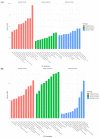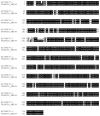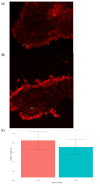The Stress Response of the Holothurian Central Nervous System: A Transcriptomic Analysis
- PMID: 36362181
- PMCID: PMC9657328
- DOI: 10.3390/ijms232113393
The Stress Response of the Holothurian Central Nervous System: A Transcriptomic Analysis
Abstract
Injury to the central nervous system (CNS) results in permanent damage and lack of function in most vertebrate animals, due to their limited regenerative capacities. In contrast, echinoderms can fully regenerate their radial nerve cord (RNC) following transection, with little to no scarring. Investigators have associated the regenerative capacity of some organisms to the stress response and inflammation produced by the injury. Here, we explore the gene activation profile of the stressed holothurian CNS. To do this, we performed RNA sequencing on isolated RNC explants submitted to the stress of transection and enzyme dissection and compared them with explants kept in culture for 3 days following dissection. We describe stress-associated genes, including members of heat-shock families, ubiquitin-related pathways, transposons, and apoptosis that were differentially expressed. Surprisingly, the stress response does not induce apoptosis in this system. Other genes associated with stress in other animal models, such as hero proteins and those associated with the integrated stress response, were not found to be differentially expressed either. Our results provide a new viewpoint on the stress response in the nervous system of an organism with amazing regenerative capacities. This is the first step in deciphering the molecular processes that allow echinoderms to undergo fully functional CNS regeneration, and also provides a comparative view of the stress response in other organisms.
Keywords: RNA-seq; echinoderm; heat shock proteins; regeneration; spinal cord injury; ubiquitin.
Conflict of interest statement
The authors declare no conflict of interest.
Figures






Similar articles
-
Dedifferentiation of radial glia-like cells is observed in in vitro explants of holothurian radial nerve cord.J Neurosci Methods. 2021 Dec 1;364:109358. doi: 10.1016/j.jneumeth.2021.109358. Epub 2021 Sep 17. J Neurosci Methods. 2021. PMID: 34537226 Free PMC article.
-
Regeneration of the radial nerve cord in the sea cucumber Holothuria glaberrima.BMC Dev Biol. 2009 Jan 6;9:3. doi: 10.1186/1471-213X-9-3. BMC Dev Biol. 2009. PMID: 19126208 Free PMC article.
-
Transcriptomic changes during regeneration of the central nervous system in an echinoderm.BMC Genomics. 2014 May 12;15:357. doi: 10.1186/1471-2164-15-357. BMC Genomics. 2014. PMID: 24886271 Free PMC article.
-
The African clawed frog Xenopus laevis: A model organism to study regeneration of the central nervous system.Neurosci Lett. 2017 Jun 23;652:82-93. doi: 10.1016/j.neulet.2016.09.054. Epub 2016 Sep 29. Neurosci Lett. 2017. PMID: 27693567 Review.
-
Updates and challenges of axon regeneration in the mammalian central nervous system.J Mol Cell Biol. 2020 Oct 1;12(10):798-806. doi: 10.1093/jmcb/mjaa026. J Mol Cell Biol. 2020. PMID: 32470988 Free PMC article. Review.
Cited by
-
Sea cucumbers: an emerging system in evo-devo.Evodevo. 2024 Feb 17;15(1):3. doi: 10.1186/s13227-023-00220-0. Evodevo. 2024. PMID: 38368336 Free PMC article. Review.
References
-
- Lapuente-Chala C., Céspedes-Rubio A. Biochemical Events Related to Glial Response in Spinal Cord Injury. Rev. Fac. Med. 2018;66:269–277. doi: 10.15446/revfacmed.v66n2.61701. - DOI
-
- Chen K., Deng S., Lu H., Zheng Y., Yang G., Kim D., Cao Q., Wu J.Q. RNA-Seq Characterization of Spinal Cord Injury Transcriptome in Acute/Subacute Phases: A Resource for Understanding the Pathology at the Systems Level. PLoS ONE. 2013;8:e72567. doi: 10.1371/journal.pone.0072567. - DOI - PMC - PubMed
MeSH terms
Grants and funding
LinkOut - more resources
Full Text Sources
Medical
Miscellaneous

